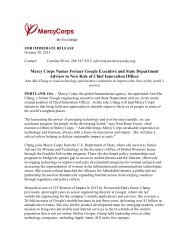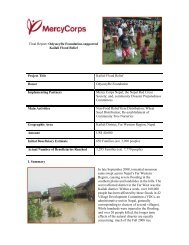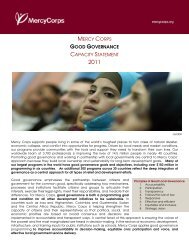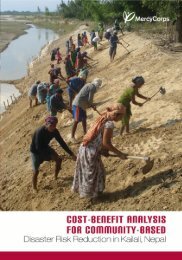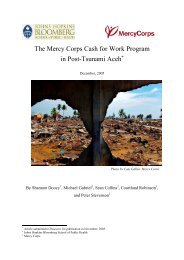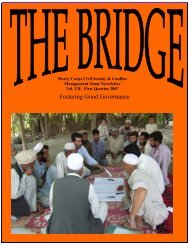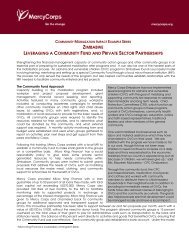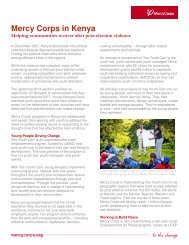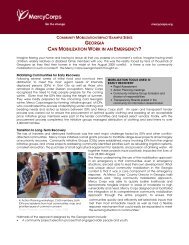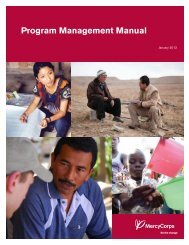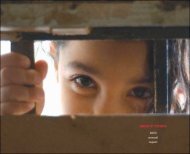SUSTAINABILITY FIELD STUDY - Mercy Corps
SUSTAINABILITY FIELD STUDY - Mercy Corps
SUSTAINABILITY FIELD STUDY - Mercy Corps
You also want an ePaper? Increase the reach of your titles
YUMPU automatically turns print PDFs into web optimized ePapers that Google loves.
In each community, the teams sought to interview two former CAG members, two youths associatedwith the project and three members of the general population. In most places, interviews were heldwith one local government official at the Jamoat / Aiyl Okmotu 11 level for each Jamoat / Aiyl Okmotuvisited (some communities were in the same Jamoat / Aiyl Okmotu). In some instances, someoneat the Raion (district) level was also interviewed about the communities in its jurisdiction. Table 3provides demographic data for all interviewees.Figure 1: Age Distribution of Interviewees80%70%60%50%40%30%20%10%0%0 to 18 19 to 25 26 to 40 41 to 60 61 +CAGYouthGeneral CommunityLocal GovernmentA total of 389 interviews were held. CAG and Local Government respondents included manymore men than women, a likely reflection of the gender balance of these roles within Tajikistan andKyrgyzstan. It was also a result of the study’s strategy to reach out first to CAG chairs, who werealmost always men due to the cultural propensity toward men holding positions of power. The dominantage group for CAG, general community and local government interviewees was 41-60, reflectingthe prominence of this age group in positions of authority within society, as well as the greater presenceand availability of this age group within communities given the high level of out migration amongthe younger generation (see Figure 1).Interviewee SelectionCAG members and youth were identified using a list of committee members, where available, orreferrals from the local government representative, starting with the Chair. The team would select asecond CAG member, based on availability, gender (seeking balance), and the Chair’s assessmentof the more active members. Similarly, where no youth committee was formed (PCI) or no list wasavailable, the CAG members would be asked to identify available youth involved in the <strong>Mercy</strong> <strong>Corps</strong>programs. General Community members were selected through a blind selection of household visits,usually from different parts of each community to avoid multiple members of families or close friendsbeing interviewed. The Local Government member interviewed depended on availability and thediscretion of the Rais (Government Chairperson).D. Methodology ConstraintsThe chosen methodology allowed for a random and wide sampling of communities from both CAIPand PCI within Kyrgyzstan and Tajikistan. However, the methodology does pose a few key constraintsthat should be considered when evaluating the data and results.11 Smallest level of government responsible for a small cluster of villages: Jamoat in Tajikistan or Aiyl Okmotu in Kyrgyzstan.14Sustainability Field Study



